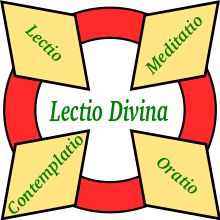Lectio Divina is a spiritual practice which has its roots in the Christian tradition. It is a formalized process whereby the reader intentionally interacts with the texts in a way very different from the casual reader or even the typical student.

The four movements of Lectio Divina. Clockwise from top left: Lectio (“read”); Meditatio (“meditate”); Oratio (“pray”); Contemplatio (“contemplate”).
To be fair, I am removing this practice from the context in which it was recorded. The needs of a Christian devotee and the needs of a practicing Stoic are not nondifferent. So, in the interests of intellectual integrity, will note that I’m changing things. I will be explicit about that when I do, and I will make a note in the title of the practice.
It is important to remember, that most of the core Stoic texts were not intended to be read.. Epictetus’s Discourses as recorded by Arrian are a noting or paraphrasing of spoken lectures. The same being true for Musonius Rufus. Marcus’s meditations were a private journal, also not meant for a sit-down reading by an audience. Seneca’s Moral Letters were epistles, so that is also a different format than the modern is used to. Much of philosophical consumption would have happened aurally for the ancients.
Sitting and reading the Stoics as we might read a novel, or history, may not be the best way to consume the material. With that in mind, I began to look at other was of reading.
Lectio Divina has its roots in western monastic practices. I’ve seen some arguments that it was devised for a time when books were expensive and time-consuming to produce. Communal reading would be a logistical requirement, then, in that time and place. This has not been entirely lost, I spent some time at a monastery as young-teenager, and during meal time religious and ethical texts were read aloud by one of the brethren while the rest ate in silence and contemplation. This was, subjectively, very nice.
However, this logistical need changed as the culture changed. It became a private practice, of individual contemplation. This is the thing which most interests me, the interaction of the student with the text. Once the practice was formalized, some 900 years after its inception, it had four distinct parts. Read, meditate, pray, contemplate. Let’s look at these each in turn.
Read: the practitioner, with a calm and tranquil mind, intentionally reads the the passage with the intent of having a higher level of understanding. Benedictines traditionally read slowly, and re-read four times. Each time, they focus on a different portion of the passage.
Mediate: Traditionally, this is not an analytical process, but one in which the reader is open to divine inspiration. Rather than parse the text, the reader opens to a frame of mind to experience the purpose of the text.
Pray: For the reader, a communication with God would follow.
Contemplate: namely, silent experience.
Now, it is worth nothing that there are core differences for Stoics and Christians. Stoics do not view their texts as divinely inspired. Stoic texts are a product of reason, not revelation. The words of the classics are not the immutable laws of God given to man. They are the words of men, given to man.
There is an elephant in the room which needs to be addressed here. There is a divide in the Stoic community which tends to fall on theistic/deistic/atheistic/anti-theistic lines. I am interested in Stoic physics, and Stoic theology. so that sort of de facto places me into one of the camps, even though I find the partisanship odious.
It needs to be said however that the God of the Stoics is not the God of the Abrahamic faiths. It is not transcendent, but immanent. The Stoic God is not a’ personality’ hanging out in a place weighing the hearts of the dead against a feather (that’s what happens, right? It’s been a while for me…). The Stoic God is the cosmos. It is causation, the generative principle, the ordering force of the universe. It is reason, and the enlivening principle of the universe.
I don’t claim to fully understand it, or even to say firmly that I believe it. I am willing to operate provisionally with the idea that it might be true, however, while I study it more.
That being said, if a Stoic were to pray outside of some other formal religion, I don’t know what that would look like. Marcus has some ideas, as does Seneca. Seneca suggests we clap with children at the Saturnalia, or we might respond to a “Merry Christmas.” Marcus suggests that if we were to petition God, it would be for virtue, not stuff or circumstances to our liking. A Christian, Greek Polytheist, or other specific theist may not have this problem.
I don’t know what a Stoic prayer would look like; I’m pretty sure I’m not doing it however.
There is one school of thought that the ancients were advising us to engage in the pious actions of our society. Part of Socrates defense was that he was participating in the rites of his city, and not introducing foreign Gods to his people when he discussed the δαίμων. This, he evidenced, by his participation in all the rite and religious requirements of his day.
I’m not sure if that has relevance to us today. It would feel dishonest, or disrespectful for me to go to a church and do church-things for a group I didn’t believe in. That feels like a lie. I do occasionally go with friends or family, but I only participate in the general portions, nothing specific or that implies an obligation or agreement on my part.

The three movements of Lectio Divina Stoica. Clockwise from top left: Lectio (“read”); Meditatio (“meditate”); Contemplatio (“contemplate”).
I can do Seneca’s thing however, take a greeting and return it in the spirit in which it was given. This has started to drift off topic, but what I am doing is laying the groundwork for altering the sections of the four-fold instruction for Lectio Divina.
My practice of what I will call Lectio Divina Stoica has three parts.
Read. Meditate. Contemplate.
Reading the passage aloud or internally is acceptable. Meditate on the passage, analytically and with an idea for how it fits into the schema of Stoicism, and how it fits into human life. Contemplate, a silent experiential incorporating of the passage.
I am trying both a reading of the texts in English and in Koine. However, my current facility with the Greek is not quite strong enough to make good use of the practice. So, that may be a task for letter. Now, on to the meat of the issue:
Lectio Divina Stoica.
Preparation.
- Begin by finding a quiet place. There is an intentionality to creating space and time for a practice of importance. This place could be outside or inside. It should be peaceful, and non-distracting. The goal here is to show a reverence for what we’re doing.
- Sit quietly, and with the eyes closed, begin to focus on the experience of the breath. Note the chest or stomach rising and falling. You can note this with a word if you like, “Rising, rising, rising. Falling, falling, falling.” You could also make use of one of the meditations here. Allow this practice to clear and quiet the mind. A couple to several minutes maybe required. Once this is done, begin with the reading.
Reading.
- A passage is selected, you could use a Daily Reader (there are several available), or you could work through a Stoic text beginning to end, or you could pick one randomly. You may want to build a “handbook” of topical selections, and focus on one point of virtue, one point of practice, or any portion of our School in which you desire a deeper understanding. Slowly, aloud or internally as you prefer, read the text; focusing on the meaning of the words, and with attentive reverence, read. When a portion of the text stands out to you, or strikes a chord, or elicits a response of some sort, stop and reflect on it. You might highlight or underline the passage, make a note in the margin, or otherwise set it off as something of particular note.
Meditate.
- Here, we may go over the passage again, looking for a deeper meaning to what is present.What is the meaning of the passage? How does it fit into our school? How does it help us train to virtue? What does the noting of the passage say about us, why are we noting this part now? Is it directly applicable to some part of our lives? Is it agreeable or disagreeable? Why? Will it change our practice? Does it change our understanding of virtue, of the cosmos, and our place in it? Do we agree or disagree with the text here?In short: What does the text say? What does the text say to me? What does it mean for our School? What does it change in my practice?
Contemplate.
- We quietly sit and rest in the message of the text. If outside, a quiet observation of nature would be appropriate. If inside, of ourselves, the process of reason and understanding. Sit in quietness, and appreciate the opportunity to learn, grow, and strive for human virtue.
 When the Sage is viewed in this light, she’s a more comforting role model to my way of thinking. Not a superman, but a *real* one. Precisely the one Diogenes goes to look for with his lamp. Sometimes that passage gets translated as real man, sometimes as honest man, but either way.
When the Sage is viewed in this light, she’s a more comforting role model to my way of thinking. Not a superman, but a *real* one. Precisely the one Diogenes goes to look for with his lamp. Sometimes that passage gets translated as real man, sometimes as honest man, but either way.
 No. There is clear taxonomy of what constitutes “Something” for Stoics. Bodies and incorporeals are Something. Everything else is not-Something.
No. There is clear taxonomy of what constitutes “Something” for Stoics. Bodies and incorporeals are Something. Everything else is not-Something.

 Franco Scalenghe has translated all of Epictetus’ known works (via Arrian), and graciously made them available without cost to the reader. If you haven’t leafed through his translation, I highly recommend it.
Franco Scalenghe has translated all of Epictetus’ known works (via Arrian), and graciously made them available without cost to the reader. If you haven’t leafed through his translation, I highly recommend it.

You must be logged in to post a comment.